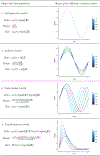Statistical Inference for Counting Processes Under Shape Heterogeneity
- PMID: 39562008
- PMCID: PMC12045460
- DOI: 10.1002/sim.10280
Statistical Inference for Counting Processes Under Shape Heterogeneity
Abstract
Proportional rate models are among the most popular methods for analyzing recurrent event data. Although providing a straightforward rate-ratio interpretation of covariate effects, the proportional rate assumption implies that covariates do not modify the shape of the rate function. When the proportionality assumption fails to hold, we propose to characterize covariate effects on the rate function through two types of parameters: the shape parameters and the size parameters. The former allows the covariates to flexibly affect the shape of the rate function, and the latter retains the interpretability of covariate effects on the magnitude of the rate function. To overcome the challenges in simultaneously estimating the two sets of parameters, we propose a conditional pseudolikelihood approach to eliminate the size parameters in shape estimation, followed by an event count projection approach for size estimation. The proposed estimators are asymptotically normal with a root- convergence rate. Simulation studies and an analysis of recurrent hospitalizations using SEER-Medicare data are conducted to illustrate the proposed methods.
Keywords: dimension reduction; kernel smoothing; recurrent event process; single index model.
© 2024 John Wiley & Sons Ltd.
Conflict of interest statement
Conflicts of Interest
The authors declare no conflicts of interest.
Figures


Similar articles
-
Statistical inference on shape and size indexes for counting processes.Biometrika. 2022 Mar;109(1):195-208. doi: 10.1093/biomet/asab008. Epub 2021 Feb 12. Biometrika. 2022. PMID: 37790796 Free PMC article.
-
Recurrent event data analysis with intermittently observed time-varying covariates.Stat Med. 2016 Aug 15;35(18):3049-65. doi: 10.1002/sim.6901. Epub 2016 Feb 16. Stat Med. 2016. PMID: 26887664 Free PMC article.
-
Likelihood approaches for proportional likelihood ratio model with right-censored data.Stat Med. 2014 Jun 30;33(14):2467-79. doi: 10.1002/sim.6105. Epub 2014 Feb 6. Stat Med. 2014. PMID: 24500821 Free PMC article.
-
Semiparametric estimation in generalized linear mixed models with auxiliary covariates: a pairwise likelihood approach.Biometrics. 2014 Dec;70(4):910-9. doi: 10.1111/biom.12208. Epub 2014 Sep 23. Biometrics. 2014. PMID: 25251282
-
An estimating function approach to the analysis of recurrent and terminal events.Biometrics. 2013 Jun;69(2):366-74. doi: 10.1111/biom.12025. Epub 2013 May 7. Biometrics. 2013. PMID: 23651362 Free PMC article.
References
-
- Lawless JF and Nadeau C, “Some Simple Robust Methods for the Analysis of Recurrent Events,” Technometrics 37, no. 2 (1995): 158–168.
-
- Lin DY, Wei LJ, Yang I, and Ying Z, “Semiparametric Regression for the Mean and Rate Functions of Recurrent Events,” Journal of the Royal Statistical Society: Series B 62, no. 4 (2000): 711–730.
-
- Gail M, Santner T, and Brown C, “An Analysis of Comparative Carcinogenesis Experiments Based on Multiple Times to Tumor,” Biometrics 36 (1980): 255–266. - PubMed
-
- Prentice RL, Williams BJ, and Peterson AV, “On the Regression Analysis of Multivariate Failure Time Data,” Biometrika 68, no. 2 (1981): 373–379.
-
- Andersen PK and Gill RD, “Cox’s Regression Model for Counting Processes: A Large Sample Study,” Annals of Statistics 10 (1982): 1100–1120.
MeSH terms
Grants and funding
LinkOut - more resources
Full Text Sources
